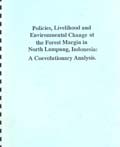| Thesis |
 |
|
| Title | Policies, livelihood and environmental change at the forest margin in North Lampung, Indonesia
A Coevolutionary Analysis | | Author | Remi Charles Talbot Gauthier | | Year | 1998 | | Academic Departement, University | University of London | | City | London, UK | | Number of Pages | 405 | | Departement | Wye College | | Degree | PhD | | Call Number | TD0052-04 | | Keywords | Policies, Livelihood, Environmental, Forest, North Lampung, Indonesia, Coevolutionary |
|
| Abstract: |
| A non-equilibrium coevolutionary framework, coupled with structuration theory, was used to analyse the relationships between livelihoods, environmental change and agro-environrnental policies at the forest margin in North Lampung, Indonesia.
The research was based on extensive field data gathering, and used a hybrid methodological approach which integrates qualitative and quantitative analysis, to address the socia-cultural and the bio-physical aspects of forest margin dynamics. Wildlife, in particular vertebrate pest profile, was used as an indicator of environmental change.
The particular socio-environrnental situation of a location is a result of the dynamic, co evolving interrelationships between community, household and individual actors, government policy and the bio-physical setting, where each will influence the others, causing further change which in turn impacts upon the causal factors. This thesis identifies the dynamics involved in the processes of environmental transfonnation at the forest edge in North Larnpung, and the role of, and implications for agro-environmental policies.
The livelihood strategies of Jav.anese immigrant and indigenous Lampungese forest margin communities are analysed and Government policies applicable to the research area, in particular transmigration and agricultural development, are reviewed.
Their impacts on livelihoods and the environment are assessed, and the emerging dynamic between policy, livelihood and the environment is tracked through recent time. The research analyses the links between social actors and structures which influence livelihood strategies and local environmental transformation. The transformed environment is shown to have an effect on livelihood strategies, as well as the bio-physical for policy implementation. The pivotal roles of social actor interactions and learning within the coevolutionary process are highlighted. |
|